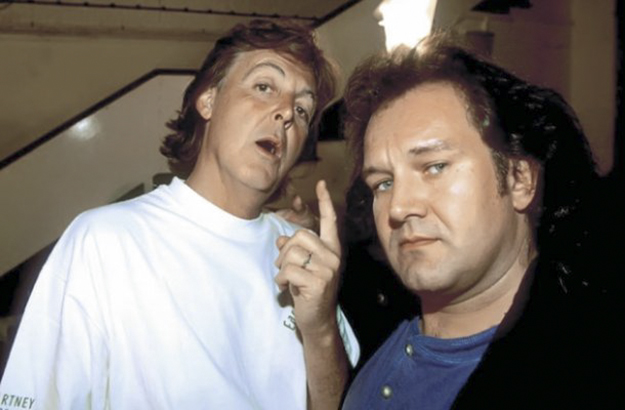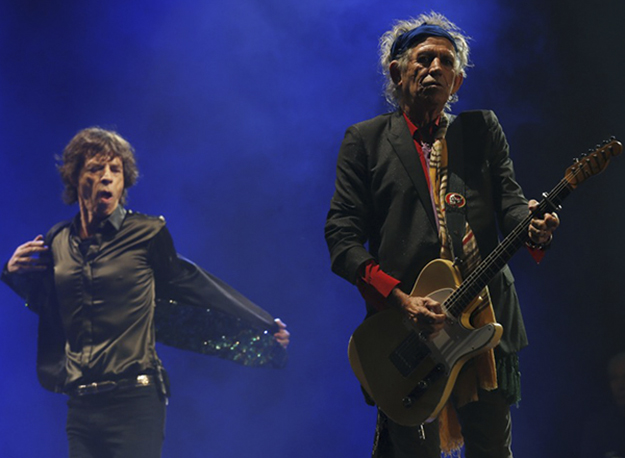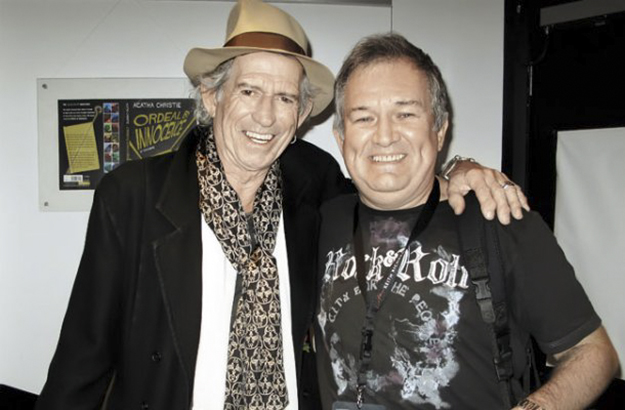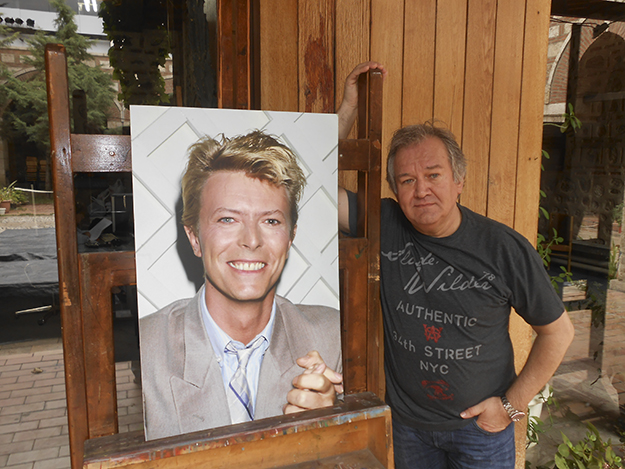There is a delicate relationship that exists between music photographers and rock stars. It’s almost a symbiotic connection as both parties engage in a dynamic dance that results in images that help their audiences to identify with both the artists and the music they create. Some photographers just capture images and are soon forgotten, while some capture moments and magic, and their photographs are still revered for the moments they have immortalized.
Photographer Brian Rasic has been taking photographs professionally for more than 35 years. Since the late ’70s he has been capturing the passion and energy of rock & roll and pop music’s most influential performers. At the start of the ’80s he moved to London where his passion for photography fully blossomed and became a full-time profession.
In the intervening 35 years, the list of musicians he has snapped reads like a who’s who of the industry: Led Zeppelin, The Rolling Stones, Pink Floyd, David Bowie, Paul McCartney, Duran Duran, U2, New Order, Amy Winehouse, to name but a few. He worked alongside Svetislav Stojanovic Sasha and regularly reported about the London music scene for the media in the ‘80s.

Rasic (right) has photographed many of the music industry’s biggest stars over the course of the past 35 years, including Paul McCartney. Photo courtesy of Brian Rasic.
Throughout the years, people not only recognized him for training his lenses at various popular acts, but also for lengthy collaborations with people such as The Rolling Stones, David Gilmour and David Bowie. At this stage of the Stones’ career, the band is touring South America, something the band hasn’t done in a while, with performances in probably all the major cities in the continent. As part of the band’s performance in Lima, Peru, Rasic was invited to exhibit his photographs of the band but only from the band’s recent tours rather than ancient history.
When guitarist David Gilmour of Pink Floyd fame began his tour in 2015, the poster featured a Rasic photograph. He was there at the very first concert of the tour happening at the Roman amphitheater in Pula, Croatia. Brian was the sole photographer at the fame concert by Gilmour at the Royal Albert Hall with guest appearance by David Bowie which was one of his last public performances.
Bowie’s passing at the start of January this year was a shock and the shockwaves were felt worldwide. Rasic began taking photographs of Bowie starting from 1983 and since then he followed his career path throughout his various stages until his last live performances which included his guest performance at David Gilmour’s concert in 2006. Last year, a selection of those photographs was exhibited at the Skopje Cinema City Film Festival, when the festival opened with a Tribute to Bowie by screening a selection of documentaries about this artist along with Brian’s photographs.
K2.0 talked with Rasic via telephone to discuss his beginnings as a photographer in ‘70s Belgrade, his journeys across Europe photographing bands and his work with the Rolling Stones and the late, great David Bowie.
K2.0: How did you get started in photography and why photography in the first place?
Brian Rasic: Photography was a kind of magic back in the day. A camera, some film, a darkroom and the light on the paper would create a picture. I felt something special about it when I entered that world. I started photographing girlfriends, friends, parties, and exploring the art of it with landscapes and portraits. I am a self made photographer, I learned the tricks of the trade all by myself. Of course, there were people to guide me and help me on the way.
Music had also become part of my life and as soon as I started going to gigs, I had the urge to photograph those as well. I mean, there were people on stage I considered idols that I could later take a picture of and share with my friends.
Being self-taught helped me to get as close as possible to understanding the light. It is the light that creates a photograph. I was operating with Russian cameras that belong to my father and uncle. They were good but I only worked with one lens that was 50mm, the so called ‘normal’ lens. Not that I felt I was missing anything, but in time I got my first Nikon and a few lenses and the rest is, as they say, history.
What was the music scene like in former Yugoslavia at the time of your youth?
In the beginning it was local bands that I liked. I felt that having a picture taken by me was something special, so much more then having it taken by someone from a magazine. Times were different and nobody would even ask me what I was doing when I made my way to the front of the stage once the lights went off and the concert started. Back then we had bands like Deep Purple, Jethro Tull, and Ike and Tina Turner all coming to play Belgrade. That was more challenging. I’d buy a ticket and make my way to the front. That was it. It was just for myself and my friends that I was doing it. Pure joy.
How did you get into the photography business?
In the early seventies I found myself living in Zurich in Switzerland as I had the opportunity to do so through a family member who was working there. Of course, there were many more gigs there. I saw Rory Gallagher, War, Roxy Music, AC/DC. I still did not have my own camera and was using whatever was given to me by people I knew. Taking pictures became more difficult as there was more control there than back at home. When I went to Bern in 1973 to see The Rolling Stones for the first time ever, I did not dare to take a camera as the ticket had a warning: no cameras allowed. I mean, I couldn’t afford to not be let in or get kicked out. And yes, I did see The Stones and that kind of changed my life.
During my studies in Belgrade, I was working in a travel agency to get some cash, and during those times I bought myself my first Nikon camera which was great. With the travel agency I was able to fly to places in Europe for short breaks, almost for free, and I took every opportunity to do so. One of my favourite places was London. I went there a few times and of course, I met a girl. Then I was invited to her’s for Christmas.
Back home in Yugoslavia thing were ‘cooking’ on a political level and even though I wasn’t really bothered about it all, almost by coincidence I ended up in London back in 1979. Not that I had plans to stay. It just happened.
What made you move to London and pursue photography?
Once I found myself in London, it was like I was in a ‘Neverland’ of music. So many gigs, so much to see… but, it wasn’t for free of course. I would buy a ticket and try to take my camera in. It did work, but not always. Then I had the idea of getting in touch with a music magazine in Belgrade and offering them my services. In exchange I could use their name and apply for photo passes. I guess one needs some luck as well and I was put in touch with a guy who was a writer here for the same magazine. We met and became known in London as the ‘terrible twins.’
Back in the eighties we did so much work together. Sasha was interviewing musicians and reviewing gigs and I was taking pictures of it all. In the beginning we did it for just one magazine but soon I was being asked by other journalists living in London if I could do a job for them as well. One thing led to another and in 1983 I went to a photographic agency Rex Features, one of the biggest in UK and offered them my work. They took me on and started syndicating my pictures around the World through their agents. I remember giving them some pics from the Genesis video shoot for ‘Illegal Alien’ that I did for a German magazine Pop Rocky, and that was the start of my professional career worldwide.
Soon I was contributing to Japanese magazines and my work started to be noticed by many people, around the globe. I just kept taking whatever I could get. I was ‘hungry,’ as all the musicians were people I was listening to and loved or liked; Led Zeppelin, The Clash, The Who, The Rolling Stones, David Bowie. I wasn’t only doing the ‘big names’ though. I was keen to do not so well known bands as well, quite a few names that were new at the time; Duran Duran, Wham!, Culture Club, and with time they all became big. My work became like my life really. I just wanted to capture them all. I knew my music of course and I loved it. It was a labour of love.
People recognize you not only for training your lens at various popular acts but also for lengthy collaborations with people such as The Rolling Stones, David Gilmour and David Bowie. You have managed to capture historical moments that have happened in their storied careers. How does one photographer become an in-demand or a first choice photographer for the likes of these people?
My love for it, my photographic ability, my will to work, and parallel with that, getting to know people from the music industry, record companies, PR managers. Once they knew about my ability and my nature and behaviour, once they started to trust me, it was all coming my way. I always had a good relationship with the people ‘in the shadows’ that are actually creating the bands or working for them.
Today, it is very different. It’s all about ‘daddy can you buy me a camera’ and ‘becoming a photographer.’ With all due respect to my ‘family’ of true troopers that is.

One of Rasic’s most notable contributions in a glittering career has been his enduring collaboration with the Rolling Stones. Pictured here with the band’s guitarist, Keith Richards. Photo courtesy of Brian Rasic.
You mentioned earlier that The Rolling Stones changed your life. How did it feel to be present at some of their biggest and most important concerts in this chapter of their career like the ones in Rio, Glastonbury and Hyde Park?
When I work, I get lost in it. I lose a lot by missing the music but work is the priority. It’s like being in a bubble, in your own world where you can only concentrate on what you’re supposed to do. Every now and then I have to recognize what is going on and capture the feeling of the place. The joy of the crowd, that is obvious. When I hear some of my favourite songs, I try to just enjoy the moment, but never missing the picture of course. I do not have rules or patterns. I just do it. I feel responsible and like I have butterflies in my tummy. You can never be too sure. That keeps me going.
All these huge places like Copacabana in Rio or Glastonbury, they became a club in my head; they have to because when you really look at it, it can be quite scary. I tend to cut myself out of whatever situation it is and snap it in my own world. Then again, when I get to shoot from stage and see all those people in front… WOW! Sometimes it even makes me proud of myself. Of course I am proud. Working with the biggest rock band ever doesn’t happen to many of us. Being there is almost more than a dream. I could never have dreamt of doing it, being there, when I was growing up in Belgrade, my home town.

Rasic worked closely with David Bowie throughout the rock star’s career. Pictured here exhibiting his photographs at the Skopje Cinema City Film Festival in 2015. Photo by Nenad Georgievski.
You had the opportunity to work closely over the years with the late David Bowie. Could you reflect on the working relationship with this great man?
I’m very proud of my work with Bowie and so sad at his passing. One of the geniuses of popular music. I started working with David through his PR company, ‘Outside.’ I covered several gigs for him, back with Tin Machine and as a solo artist, big gigs and closed door shows too, including at the BBC a couple of times.
I saw him for the first time in April 1983 for the Let’s Dance album press launch. It’s his most successful album and the one he likes the least. I’d done some pics and his PR showed them to him and he liked them. I got his autograph too. I was a fan after all. Then over the years they would hire me to do gigs in Europe and here in London, I did several after-show parties for him as well, posed pictures.

Rasic worked closely with David Bowie throughout the rock star’s career. Pictured here exhibiting his photographs at the Skopje Cinema City Film Festival in 2015. Photo by Nenad Georgievski.
The last time I took pics of him on stage was with David Gilmour in 2006 as he was a special guest during a couple of songs and I was working with Gilmour for those shows. David was very special and somehow ‘different’ from the rest. It was always a personal joy for me to be around him and taking pictures. He wasn’t demanding in any special way and always knew what he wanted. I just needed to do it and it was nice and easy. I just needed to be there. He was a gentleman on and off stage. One of the greatest. Bless his soul.
What are your thoughts about the newest generations of artists?
I am slowly getting lost in today’s world of music, to be honest. There is just so much of every kind of music, so many different artists and types of music. It’s mindboggling. Yet, I am still ‘lens objective’ as I like to say. And of course, taking pics of Rihanna and Lady Gaga is never boring. Taylor Swift as well. I do recognise and respect new artists of course and still work with them respectfully. But my musical preferences remain the same, and are based on the music from the time when I was growing up and the world was a different place. Today I can hear lots of that even in new music and artists. People need new, and new sells. It’s a never ending story.K
Photos: Brian Rasic and Nenad Georgievski. Portrait of Rasic by Nemanja Djordjevic.

